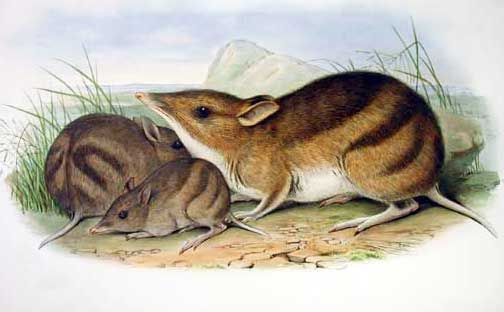Perameles gunnii (*) Cladus: Eukaryota Name Perameles gunnii Gray, 1838 Type locality: Australia, Tasmania Vernacular names References * Perameles gunnii on Mammal Species of the World. ------------ The Eastern Barred Bandicoot (Perameles gunni), was once distributed across the Basalt Plains of south west Victoria, and in Tasmania.[3] It is a small, rabbit sized marsupial weighing less than 1 kg with a short tail and three to four whitish bars across the rump.[3] It lives for just two to three years and is non gregarious.[3] Males occupy large home ranges compared to females and only consort with females for mating. This species is nocturnal. It emerges from its nest at dusk to forage for a variety of invertebrates including crickets, beetles and earthworms.[3] During the day it rests in a grass-lined nest. When foraging, it uses its long nose to probe deep into the soil and then digs eagerly when it locates food. Females have 8 nipples and can produce a maximum of 5 young in one litter with an average of 2 to 3 young. Gestation lasts just 12 days—this is one of the shortest gestation periods of any mammal. Young are weaned at 55 days and emerged juveniles remain dependent upon the mother and forage with her until day 86.[3] Given ideal conditions, females can have up to five litters per year although reproduction becomes depressed in summer and ceases altogether in times of drought.[3] Due to predation by introduced foxes and cats, along with land-clearing for farming practises, the Victorian subspecies is critically endangered. Since 1989, eight reintroduction sites have been established across the bandicoot's former range. Unfortunately, populations at four sites are now extinct (Floating Islands Nature Reserve, Lanark, Cobra Killuc Wildlife Reserve and Lake Goldsmith Nature Reserve), functionally extinct at Woodlands Historic park, declining at Mooramong and increasing at Hamilton Community Parklands and Mount Rothwell.[3] The last remaining wild population which was once found along the Grange Burn (a creek) in Hamilton has also been declared extinct. The estimated population size for the Victorian Eastern Barred bandicoot is 150 individuals.[3] The Tasmanian subspecies (P. g. gunni) is vulnerable to extinction.[4] The Eastern Barred Bandicoot is most closely related to the other species of bandicoot in its genus, of which only two species are still extant today. These surviving relatives are the Western Barred Bandicoot (P. bougainville) and the Long-nosed Bandicoot (P. Nastua). It is also closely related to the Desert Bandicoot of the same genus, but this species has become extinct. There are about 20 other Bandicoots in the same family, Peramelidae. They share similar features of long pointed snouts, and small ears. The Bandicoots are closely related to the Bilbies, which share the same order, Peramelemorphia. These are all from the infraclass Marsupialia, shared of course with other species such as koalas and kangaroos, which means they diverged from the other placental mammals about 100 million years ago. All the species of this order are native to Australia and New Guinea; however it is unclear how closely related this order is to the rest of the marsupials. The bandicoots have two features that suggest separate and quite opposite ideas of their evolution. They have three pairs of lower front incisors, which would usually suggest evolution from the order Dasyuromorphia, which consists of carnivorous marsupials; however, the bandicoot’s middle two digits are syndactylous, meaning they are joined together except for the claw. This would suggest they share the common ancestor of the Diprotodontia which includes the kangaroos and koalas. There are, of course, theories using these features to describe their evolution. The incisors could, in fact, be analogous features shared between the bandicoot and the Dasyuromorphia order. They share the same function, after all, and though they are structurally similar the incisors of the carnivorous marsupials are a lot sharper then the flatter versions in the Bandicoot. The Bandicoot may have evolved the third tooth separately. If this was the case, it would seem logical that the syndactyly feet were homologous features shared between the Bandicoots and the kangaroos, wombats, possums and other species. This would make sense as syndactyly is so rare it is unlikely that it would evolve twice in two separate populations. The feet of the bandicoot when compared, to say, the kangaroo are structurally quite similar. This similarity suggests that the bandicoots shared a more recent ancestor with them. Nevertheless, though this idea is more likely, simply because of the rarity of syndactyly, it is possible that syndactyly evolved in the two different populations, and that bandicoots are actually more closely related to species such as the Tasmanian devils and the Numbat. This would mean the incisors were homologous features, structurally the same but with a slightly different function (as the carnivorous marsupials use them to rip through flesh), and the syndactyly hind feet are analogous features, as they are used for the same basic function but are not evidence of divergent evolution. Molecular evidence does not prove or disprove any of these theories, or any other related theories that are not suggested here. It is not quite definitive where the bandicoot sits exactly in the tree of life, but whatever the case, it seems that the relationship between the bandicoots and bilbies with the other orders is a distant one. Cultural impact Crash Bandicoot, the main character of the best-selling Crash Bandicoot series of video games, is classified as an Eastern Barred Bandicoot.[5] References 1. ^ Groves, C. (2005). Wilson, D. E., & Reeder, D. M. ed. Mammal Species of the World (3rd ed.). Johns Hopkins University Press. pp. 40. ISBN 0-801-88221-4. http://www.bucknell.edu/msw3. Source: Wikispecies, Wikipedia: All text is available under the terms of the GNU Free Documentation License |
|


